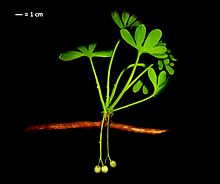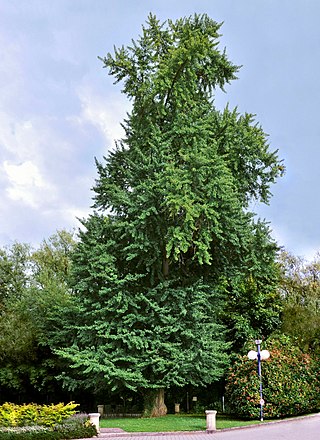
Ginkgo biloba, commonly known as ginkgo or gingko, also known as the maidenhair tree, is a species of gymnosperm tree native to China. It is the last living species in the order Ginkgoales, which first appeared over 290 million years ago. Fossils very similar to the living species, belonging to the genus Ginkgo, extend back to the Middle Jurassic approximately 170 million years ago. The tree was cultivated early in human history and remains commonly planted.
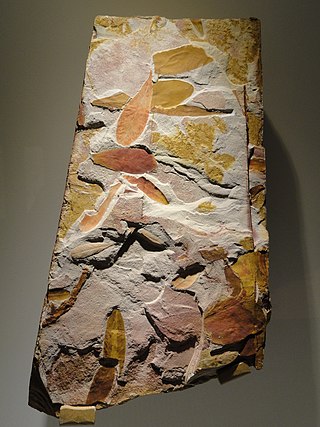
Glossopteris [etymology: from Ancient Greek γλῶσσα + πτερίς ] is the largest and best-known genus of the extinct Permian order of seed plants known as Glossopteridales. The genus Glossopteris refers only to leaves, within a framework of form genera used in paleobotany. Species of Glossopteris were the dominant trees of the middle to high-latitude lowland vegetation across the supercontinent Gondwana during the Permian Period. Glossopteris fossils were critical in recognizing former connections between the various fragments of Gondwana: South America, Africa, India, Australia, New Zealand, and Antarctica.

Chaetocarpeae is a tribe of plant of the family Euphorbiaceae. It comprises 2 genera.
Palissya is an extinct form genus of female (ovule-bearing) conifer cones, known from the Late Triassic (Rhaetian) to the Early Cretaceous (Aptian). The cone of Palissya is noted for its unusual catkin-like construction: Slender bracts are rigidly attached in a helical pattern around a tall woody core. The adaxial (upper) surface of each bract bears two parallel rows of ovules which are encased in cup-like structures formed by scales. The seeds are thin-walled and were likely only viable for a short period of time, meaning that they were probably adapted to wind dispersal.
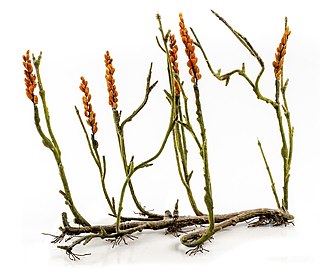
The zosterophylls are a group of extinct land plants that first appeared in the Silurian period. The taxon was first established by Banks in 1968 as the subdivision Zosterophyllophytina; they have since also been treated as the division Zosterophyllophyta or Zosterophyta and the class or plesion Zosterophyllopsida or Zosteropsida. They were among the first vascular plants in the fossil record, and had a world-wide distribution. They were probably stem-group lycophytes, forming a sister group to the ancestors of the living lycophytes. By the late Silurian a diverse assemblage of species existed, examples of which have been found fossilised in what is now Bathurst Island in Arctic Canada.
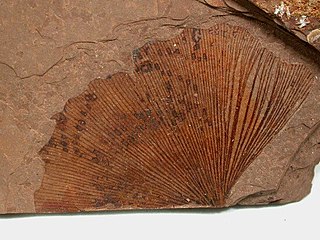
Ginkgo is a genus of non-flowering seed plants. The scientific name is also used as the English name. The order to which it belongs, Ginkgoales, first appeared in the Permian, 270 million years ago, and Ginkgo is now the only living genus within the order. The rate of evolution within the genus has been slow, and almost all its species had become extinct by the end of the Pliocene. The sole surviving species, Ginkgo biloba is only found in the wild in China, but is cultivated around the world. The relationships between ginkgos and other groups of plants are not fully resolved.

The Medullosales is an extinct order of pteridospermous seed plants characterised by large ovules with circular cross-section and a vascularised nucellus, complex pollen-organs, stems and rachides with a dissected stele, and frond-like leaves. Their nearest still-living relatives are the cycads.

Adoketophyton is a genus of extinct vascular plants of the Early Devonian. The plant was first described in 1977 based on fossil specimens from the Posongchong Formation, Wenshan district, Yunnan, China. These were originally named Zosterophyllum subverticillatum; later the species was transferred to a new genus as Adoketophyton subverticillatum. One cladistic analysis suggested that it is a lycophyte, related to the zosterophylls. Other researchers regard its placement within the vascular plants as uncertain.

Ginkgo cranei is an extinct Ginkgo species in the family Ginkgoaceae described from a series of isolated fossil ovulate organs and leaves. The species is known from upper Paleocene sediments exposed in the state of North Dakota, US. It is the first Ginkgo species to be described from Paleogene period with reproductive structures.

Ginkgo huttonii is an extinct Ginkgo species in the family Ginkgoaceae from the Jurassic of England. The fossil is also known by the name, Ginkgoites huttonii, the genus, Ginkgoites, referring to a group of extinct members of the Ginkgoaceae. G. huttonii was a broad-leaved, deciduous gymnosperm bearing resemblance to the only living member of the Ginkgoaceae, Ginkgo biloba.
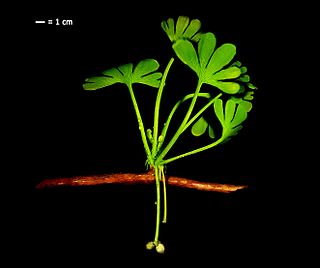
Ginkgo apodes is an extinct species of plant in the order Ginkgoales. It is known from fossils found in the Yixian Formation dated to the Tithonian period, from the Late Jurassic, located near Mount Yinwoshan, Yixian region, Liaoning Province, China.

The Price Formation is a geologic formation in Virginia. It preserves fossils dating back to the Carboniferous period.

Yimaia is a extinct genus of Ginkgoalean tree, and the only member of the family Yimaiaceae. In botanical form classification, its a form taxon for ginkgoalean ovulate organs. Yimaia species are distinguished from other Ginkgoales by the presence of "Ovulate organs consisting of a peduncle and up to eight or nine terminal, sessile, contiguous and orthotropous ovules." The ovules are associated with leaves of either Baiera or Ginkgoites leaf morphospecies. Fossils have been found in Middle Jurassic deposits in China.

Baiera is a genus of prehistoric gymnosperms in the order Ginkgoales. It is one of the oldest fossil foliage types of Ginkgoales, and is related to the genera Ginkgo and Ginkgoites. Fossils of Baiera are found worldwide, and have been known from the Permian to the Cretaceous.

The Tupuangi Formation is a geological formation in New Zealand, only exposed on Pitt Island in the Chatham Islands. It is the oldest exposed sedimentary unit within the archipelago. It was deposited in terrestrial deltaic to paralic conditions during the Cenomanian to Turonian ages of the Late Cretaceous. During this time period the Chatham Islands were attached to Antarctica within the Antarctic Circle, at approximately 70° to 80° south.
The barinophytes are a group of extinct vascular plants (tracheophytes). Their relationship with other vascular plants is unclear. They have been treated as the separate class Barinophytopsida, the order Barinophytales of uncertain class and as a family or clade Barinophytaceae within the zosterophylls. They have also been considered to be possible lycopodiopsids.
Kowieria is an extinct genus of lycopsid from the Late Devonian from Waterloo Farm, containing the single species Kowieria alveoformis. As of 2021 it is being characterised as incertae sedis. It was first described in 2017 from a black shale layer interbedded with quartzite strata of the Famennian aged Witpoort Formation.

Otozamites is an extinct form genus of leaves belonging to the Bennettitales.
This paleobotany list records new fossil plant taxa that were to be described during the year 2012, as well as notes other significant paleobotany discoveries and events which occurred during 2012.

Umaltolepis is an extinct genus of seed plant, known from the Early Jurassic to Early Cretaceous of Asia. Within the form classification system used within paleobotany, it refers to the seed-bearing reproductive structures, which grew on woody plants with strap-shaped Ginkgo-like leaves assigned to the genus Pseudotorellia.
